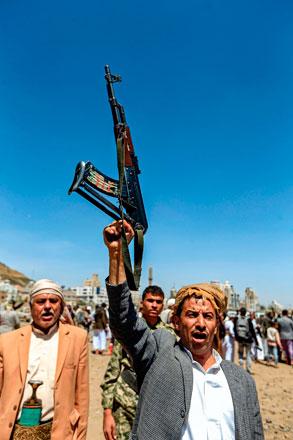You are here
Yemen pounded by war for more than five years
By AFP - Jan 19,2020 - Last updated at Jan 19,2020

Aden's seizure by southern separatists has left the Yemeni government weaker than ever, analysts say (AFP photo)
SANAA — Impoverished Yemen has been mired in a devastating conflict since Iran-backed fighters overran the capital Sanaa more than five years ago, prompting Saudi Arabia and its allies to launch a military intervention the following year.
Here is a broad overview:
Sanaa falls
On July 8, 2014, Houthi rebels from the country's Zaidi Shiite minority launch an offensive from their northern stronghold of Saada.
In September they enter Sanaa, seizing the government headquarters. Days later, rebel leader Abdelmalek Al Houthi hails the "victory" of a "popular revolution".
The rebels ally themselves with military units loyal to ex-president Ali Abdullah Saleh, who was forced to quit after a 2011 uprising.
In October, they capture the Red Sea port of Hodeida, a crucial entry point for imports and humanitarian aid.
In January 2015, they seize the presidential palace in Sanaa and surround the residence of President Abed Rabbo Mansour Hadi, who flees to the southern port of Aden.
Riyadh enters war
A coalition led by Sunni-ruled Saudi Arabia, a bitter rival of Shiite Iran, enters the conflict in March 2015 with air strikes on the rebels.
Around a dozen countries form part of the coalition, including five from the Gulf. Washington says it contributes logistics and intelligence.
As the rebels advance southwards on Aden, Hadi flees, taking refuge in Saudi Arabia.
In July Aden becomes the de facto capital of the country and in October pro-government forces announce they have retaken control of the Bab Al Mandab Strait, a key waterway for international shipping.
Battle for aid port
In June 2018, government fighters, backed by Saudi and Emirati ground forces, launch an offensive to retake the port of Hodeida.
UN-brokered talks between the warring parties open in December, yielding a series of breakthroughs including a ceasefire in Hodeida where combat largely ceases.
Southern separatists
The anti-Houthi camp is also divided, notably in the south with fighting between separatists and unionist forces loyal to the government.
South Yemen was an independent state until it united with the north in 1990, and separatists remain powerful.
In August 2019, deadly new clashes erupt and the separatist-dominated Security Belt forces, which are backed by the UAE, seize Aden and other parts of the south.
Peace initiative
On September 20, the Houthis unexpectedly announce that they plan to halt all attacks on Saudi Arabia as part of an initiative to end the devastating conflict.
It follows twin attacks on Saudi oil installations, claimed by the Houthis but widely blamed on Iran, that knocked out half of the kingdom's production.
Deadly attack
After months of relative calm, more than 80 Yemeni soldiers are killed on January 18, 2020, in an attack in central Yemen blamed on Houthi rebels.
The drone and missile strike comes a day after coalition-backed government forces launched a large-scale operation against the Houthis in the Nihm region, north of Sanaa.
Eleven Yemeni soldiers had also been killed on January 7 in a rebel missile attack on a military camp in Ad-Dali province, which has remained a flashpoint despite the lull in fighting in most of the country.
Humanitarian crisis
Yemen's conflict has killed tens of thousands of people, mostly civilians, relief agencies say, and has triggered what the UN describes as the world's worst humanitarian crisis.
The UN children's agency UNICEF describes the conflict as "a living hell" for children, with 1.8 million under-five-year-olds suffering severe malnutrition.
Related Articles
SANAA — Impoverished Yemen has been mired in a devastating conflict since Iran-backed fighters overran the capital Sanaa five years ago prom
SANAA — Saudi Arabia, whose oil installations have again been targeted by drone attacks, launched military operations in Yemen in
RIYADH — Riyadh has an "open channel" with Yemen's Iran-backed rebels with the goal of ending the country's civil war, a Saudi official said















